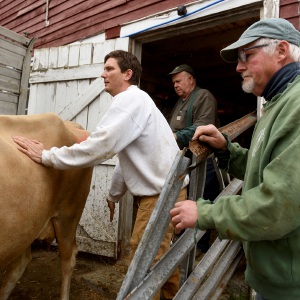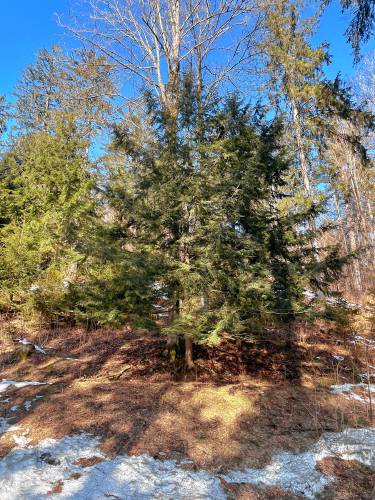Out & About: Parks Service trains volunteers to identify hemlock pest
| Published: 03-01-2024 8:01 PM |
CORNISH — The National Park Service is looking to train volunteers at the Upper Valley’s two national parks to identify an invasive insect that poses a risk to hemlock trees.
Staff will lead workshops about the small aphid-like insect at 9 a.m. Friday, March 8, at Marsh-Billing-Rockefeller National Historical Park in Woodstock and 9:30 a.m. Saturday, March 9, at Saint-Gaudens National Historical Park in Cornish. Registration is required by emailing mabi_visitorservices@nps.gov.
The adelgid attaches itself to the base of the conifer species’ needles and by feeding on them can cause more needles from properly forming.
“As this area warms, it’s putting the hemlock at increased risk of hemlock woollyadelgid impacts,” Steve Mortillo, the natural resource program lead for both parks, said in a Thursday phone interview. “We’ve been in a border zone where hemlock woollyadelgid can be present, but it could be the cold is preventing some wide-scale impact.”
Hemlock trees play an important role in both parks. They are often located on the banks of the parks’ ravines where they help stabilize the soil and cool the shade with the canopies they form with their branches.
“It’s the most abundant conifer in our forests,” Mortillo said.
Invasive species, including plants and insects, pose a threat to forest diversity. In addition to killing plant life, they can crowd out native species and be harmful to wildlife. Mortillo cited the effect the emerald ash borer beetle has had on ash trees and butternut canker, a fungus that attacks native butternut trees — both of which exist in the Twin States.
“As different tree species succumb to diseases and pests, what we’re really losing in that is forest diversity,” Mortillo said.
Article continues after...
Yesterday's Most Read Articles
 Herd departs Hartford’s last remaining dairy farm
Herd departs Hartford’s last remaining dairy farm
 At Dartmouth, hundreds protest ongoing war in Gaza and express support for academic freedom
At Dartmouth, hundreds protest ongoing war in Gaza and express support for academic freedom
 Claremont removes former police officer accused of threats from city committees
Claremont removes former police officer accused of threats from city committees
 Over Easy: ‘A breakfast without a newspaper is a horse without a saddle’
Over Easy: ‘A breakfast without a newspaper is a horse without a saddle’
The adelgid has already been detected in dozens of New Hampshire communities including Charlestown, New London and Sunapee according to a map from the New Hampshire Department of Natural and Cultural Resources Division of Forests and Lands Forest Health Program. It as also been detected in southern Vermont, according to Vermont Invasives, a program supported by the Vermont Department of Forests, Parks, & Recreation. Another invasive insect that has been detected in the Twin States — the elongate hemlock scale — also puts hemlock trees at risk in similar way.
“We’re definitely trying to get as much advance warning as we can,” Mortillo said. “We know it’s in the area and we want to make sure we’re getting out there and monitoring as best we can.”
While park staff have kept an eye out for hemlock woolly adelgids for years, this is the first time they are opening the training to the public. Anyone can participate, whether they have land of their own and want to learn more, or want to know what to look for when they’re out hiking on public lands that they can they report to land managers.
“It’s a time when community engagement and public engagement is more valuable than it’s ever been in terms of forest management and natural resource management,” Mortillo said. “One of the things we’re leaning into hard at the park is education and letting people know there’s something they can do to help.”
Once the insect is identified, then park staff can monitor the extent of the infestation and come up with a plan to manage it. That could include the use of pesticides or cutting down trees in some cases.
“Anytime you’re making an intervention like that it’s difficult, expensive and has collateral damage,” Mortillo said. “What we hope to do is to be very aware of when an infestation starts, where it starts and that gives the park and any resource manager options and time to investigate ways we can intervene.”
Liz Sauchelli can be reached at esauchelli@vnews.com or 603-727-3221.



 JAG Productions announces closure, citing ‘crisis facing the arts’
JAG Productions announces closure, citing ‘crisis facing the arts’
